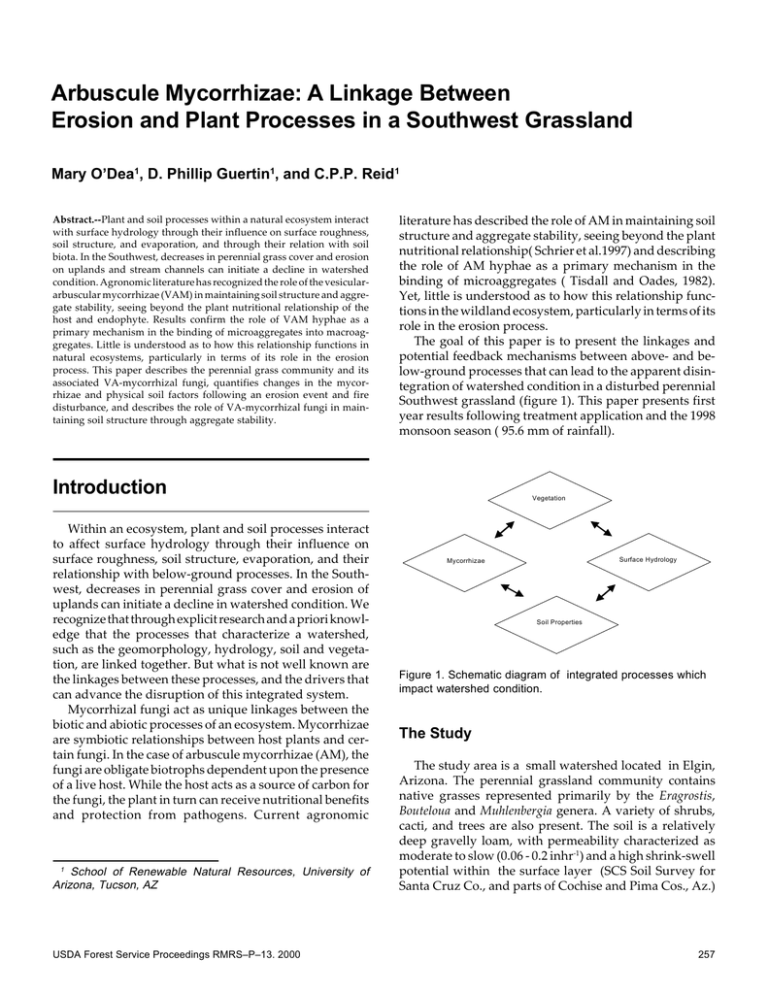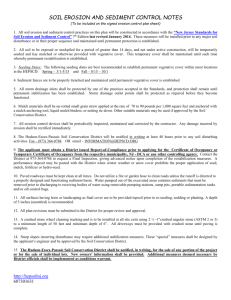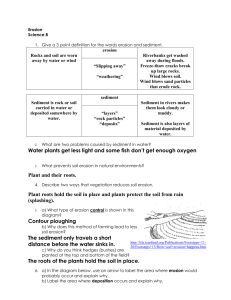Arbuscule Mycorrhizae: A Linkage Between Mary O’Dea , D. Phillip Guertin
advertisement

Arbuscule Mycorrhizae: A Linkage Between Erosion and Plant Processes in a Southwest Grassland Mary O’Dea1, D. Phillip Guertin1, and C.P.P. Reid1 Abstract.--Plant and soil processes within a natural ecosystem interact with surface hydrology through their influence on surface roughness, soil structure, and evaporation, and through their relation with soil biota. In the Southwest, decreases in perennial grass cover and erosion on uplands and stream channels can initiate a decline in watershed condition. Agronomic literature has recognized the role of the vesiculararbuscular mycorrhizae (VAM) in maintaining soil structure and aggregate stability, seeing beyond the plant nutritional relationship of the host and endophyte. Results confirm the role of VAM hyphae as a primary mechanism in the binding of microaggregates into macroaggregates. Little is understood as to how this relationship functions in natural ecosystems, particularly in terms of its role in the erosion process. This paper describes the perennial grass community and its associated VA-mycorrhizal fungi, quantifies changes in the mycorrhizae and physical soil factors following an erosion event and fire disturbance, and describes the role of VA-mycorrhizal fungi in maintaining soil structure through aggregate stability. literature has described the role of AM in maintaining soil structure and aggregate stability, seeing beyond the plant nutritional relationship( Schrier et al.1997) and describing the role of AM hyphae as a primary mechanism in the binding of microaggregates ( Tisdall and Oades, 1982). Yet, little is understood as to how this relationship functions in the wildland ecosystem, particularly in terms of its role in the erosion process. The goal of this paper is to present the linkages and potential feedback mechanisms between above- and below-ground processes that can lead to the apparent disintegration of watershed condition in a disturbed perennial Southwest grassland (figure 1). This paper presents first year results following treatment application and the 1998 monsoon season ( 95.6 mm of rainfall). Introduction Within an ecosystem, plant and soil processes interact to affect surface hydrology through their influence on surface roughness, soil structure, evaporation, and their relationship with below-ground processes. In the Southwest, decreases in perennial grass cover and erosion of uplands can initiate a decline in watershed condition. We recognize that through explicit research and a priori knowledge that the processes that characterize a watershed, such as the geomorphology, hydrology, soil and vegetation, are linked together. But what is not well known are the linkages between these processes, and the drivers that can advance the disruption of this integrated system. Mycorrhizal fungi act as unique linkages between the biotic and abiotic processes of an ecosystem. Mycorrhizae are symbiotic relationships between host plants and certain fungi. In the case of arbuscule mycorrhizae (AM), the fungi are obligate biotrophs dependent upon the presence of a live host. While the host acts as a source of carbon for the fungi, the plant in turn can receive nutritional benefits and protection from pathogens. Current agronomic 1 School of Renewable Natural Resources, University of Arizona, Tucson, AZ USDA Forest Service Proceedings RMRS–P–13. 2000 Vegetation Surface Hydrology Mycorrhizae Soil Properties Figure 1. Schematic diagram of integrated processes which impact watershed condition. The Study The study area is a small watershed located in Elgin, Arizona. The perennial grassland community contains native grasses represented primarily by the Eragrostis, Bouteloua and Muhlenbergia genera. A variety of shrubs, cacti, and trees are also present. The soil is a relatively deep gravelly loam, with permeability characterized as moderate to slow (0.06 - 0.2 inhr-1) and a high shrink-swell potential within the surface layer (SCS Soil Survey for Santa Cruz Co., and parts of Cochise and Pima Cos., Az.) 257 The study is a randomized complete block (block = replicate) with a split-plot design. Six blocks each containing four permanent runoff subplots with sediment pans were established. Four treatments were randomly applied: simulated erosion, prescribed burn (late spring), simulation and burn(simulated erosion following the prescribed burn), and a control. Following the application of the burn treatment, the plots assigned simulated erosion were treated with a rotating-boom rainfall simulator at a rate of 2.5 inhr-1 for 40 minutes. Twelve permanent sampling points were systematically established within each subplot and sampled annually following the monsoon season (early fall). All tests of hypotheses for treatment effect were evaluated at a level of statistical significance of p < 0.05. Treatment Effect on Plant Properties There were no significant differences in mean percent vegetative, cryptogam or rock cover prior to treatment application. Following the first post-treatment growing season both perennial grass and annual herbaceous cover significantly changed, reflecting treatment effects. Burned plots had significantly lower mean percent perennial grass cover. In addition, mean annual herbaceous cover was significantly higher within the simulation and burn treatment compared with the control (figure 2). There were also significant decreases in perennial grass basal area among the burned plots, 185.3 cm2 (prescribed burn) and 24.7 cm2 (simulation and burn), as well as between burned and unburned. There was no significant difference in basal area among the control ( 254.8 cm2) and simulated erosion (319.8 cm2) treatments. The significant decreases in perennial grass cover with concurrent increases in annual cover within the burned plots lead to questions regarding the stability of the highly disturbed community. Treatment Effect on Soil Properties There were no significant treatment effects on either particle size distribution or percent stable aggregates (aggregate stability) following the first season. Given the stable aggregates were 0.3 mm or smaller, the wet sieving method used to evaluate aggregate stability may not be appropriate to detect differences. The burned treatments showed significant differences in both bulk density and surface infiltration rates compared to the unburned. The burned treatments had significantly higher bulk density for the top 10 cm of the soil profile than the control, but the simulated erosion treatment did not differ significantly from any of the treatments (figure 3). Given the changes in the bulk density measurements, it was not surprising to see similar patterns in the results for surface infiltration rates. As expected, the burned treatments had significantly lower rates than the unburned treatments. Treatment Effect on Mycorrhizal Fungi Changes within the mycorrhizal fungal community were evaluated by the presence of spores and fungal biomass. Spores, because of their importance as inoculm for host plants, and fungal biomass because of its role as a soil binder. Within the bulk soil, mean AM spore number 35.0 2.00 a 30.0 1.80 ab a a a 25.0 1.40 a a b 1.20 -3 20.0 kgm Percent Cover (%) b b 1.60 15.0 0.80 c c 10.0 1.00 a \ 0.60 0.40 5.0 e de de d 0.20 0.0 Control Prescribed Burn Simulated Erosion Simulation and burn 0.00 Control Perennial Grass Herbs Figure 2. A comparison among treatments: percent cover of perennial grass and annual herbaceous plants. 258 Prescribed Burn First year Simulated erosion Simulation and burn Pre-treatment Figure 3. A comparison among treatments: changes in bulk density. USDA Forest Service Proceedings RMRS–P–13. 2000 was significantly greater in unburned treatments compared to the burned. Within the sediment pans, mean spore counts appeared to be reflective sediment yields. There was a significantly lower mean spore count within the sediment from the control compared with the other treatments. Changes in fungal biomass with treatment were also present. Fungal biomass significantly decreased within the surface 5 cm of soil following the simulation and burn treatment, but there were no significant differences among the remaining treatments. However, within the burned treatments there is significantly greater biomass lower in the soil profile, at the 6 to 10 cm depth than for the unburned treatments (figure 4). 25 15 d c d c a a b 10 5 a 0 Control P resc ribed burn 0 - 5 cm S im ulated eros ion Treatment Effect on Surface Hydrologic Properties Given the changes within the plant and fungal communities and soil structure, changes in surface hydrology were expected. Using total runoff (volume within the sediment pans) and total sediment yield (within the sediment pan) captured during the monsoon season as measures of hydrologic change, there a clear indications of treatment effect. Total runoff was significantly greater from the plots which had been treated with the rainfall simulator compared to those which had not, but runoff among the simulator plots was not significantly different. Monsoonal runoff was significantly greater for the simulation and burn treatment compared to the other treatments (figure 6). These results were not unexpected given that the simulator treatment delivered approximately 40% of the total monsoonal rainfall for 1998. Total sediment yield was highly variable among the treatments (figure 7). Sediment yield was significantly greater for the simulation and burn treatment compared to the control. However, the simula- S im ulation and burn 6 - 10 c m 900 Figure 4. A comparison among treatments: changes in fungal biomass with depth. 800 700 Volume (liters) 600 6000 5000 Predicted Sediment Yield biomass ( g/g) 20 Following the first post-treatment growing season, stable aggregate size (150 mm), fungal biomass, and treatment parameters were significant predictors of sediment yield, and helped to describe the important relationship (R2adj = 0.66) between biotic parameters and sediment yield (figure 5). 500 300 3000 200 2000 100 R2adj = 0.66 a a Prescribed Burn Simulation 0 1000 2000 3000 4000 c Simulated Erosion Simulation and burn Monsoon 5000 Actual Sediment Yield (kg) Figure 5. Sediment yield as a function of stable aggregate size, fungal biomass and treatment. USDA Forest Service Proceedings RMRS–P–13. 2000 c 0 Control 0 b 400 4000 1000 ab Figure 6. A comparison among treatments: total runoff volume from July 1, 1998 to October 1, 1998. The values do not take in to account losses due to evaporation or pan leakage. 259 4.5 b 4 3.5 Weight (kg) 3 ab ab 2.5 2 a 1.5 1 0.5 minishes the presence of obligate biotrophic fungi (AM), which are significant contributors to the stability of surface soil structure and plant community dynamics. Moreover, the disruption of soil structure or vegetative cover can directly affect hillslope hydrology and erosion dynamics. The functioning of the watershed is dependent upon the concomitant ecosystem processes operating within it, as well as the linkages between them. From these initial findings it appears that the interaction of prescribed fire and monsoonal rainfall have the potential to create an environment in which significant changes within the plant, mycorrhizae, soil, and surface hydrologic processes may occur, and thereby lead to questions about watershed condition. 0 Control Prescribed Burn Simulated Erosion Simulation and burn Figure 7. A comparison among treatments: sediment yield between July to October 1998. tion and burn treatment was not significantly different from the remaining treatments. Conclusion The burned plots showed the most dramatic changes in the first year following treatment. These plots had lowered perennial plant cover and basal area, with a shift to increased annual cover. The presence of mycorrhizal fungi was also diminished within the burned plots, most significantly within the simulation and burn treatment. Moreover, the burned plots also displayed the highest values for bulk density, the slowest values for surface infiltration rates, and the greatest sediment yield. It is important to note that although the sediment yield was not significantly different between the prescribed burn and the simulated erosion treatments, the simulated erosion treatment had been subjected to a greater amount of rainfall (approximately 40 %). Although fire is a natural disturbance within these ecosystems, the removal of host plants significantly di- 260 Acknowledgments This study is funded by the Agricultural Experiment Station, The University of Arizona, Tucson, Arizona. We would like to thank the USDA-ARS Southwest Watershed Research Center and USDI Bureau of Land Management, Tucson, Arizona for their assistance with this project. In addition, we also thank the Audubon Research Ranch, Elgin, Arizona. The authors would like to thank Peter Ffolliott, University of Arizona, and Cynthia Froyd, USDA Forest Service for their technical reviews of this paper. Literature Cited Schreiner, R.P., K.L. Mihara, H. McDaniel and G.J. Bethlenfalvay. 1997. Mycorrhizal fungi influence plant and soil functions and interactions. Plant and Soil 188: 199-209. Tisdall, J.M. and J. M. Oades1982. Organic matter and water-stable aggregates in soil. Journal of Soil Science 33(2): 141-163. USDA Forest Service Proceedings RMRS–P–13. 2000




